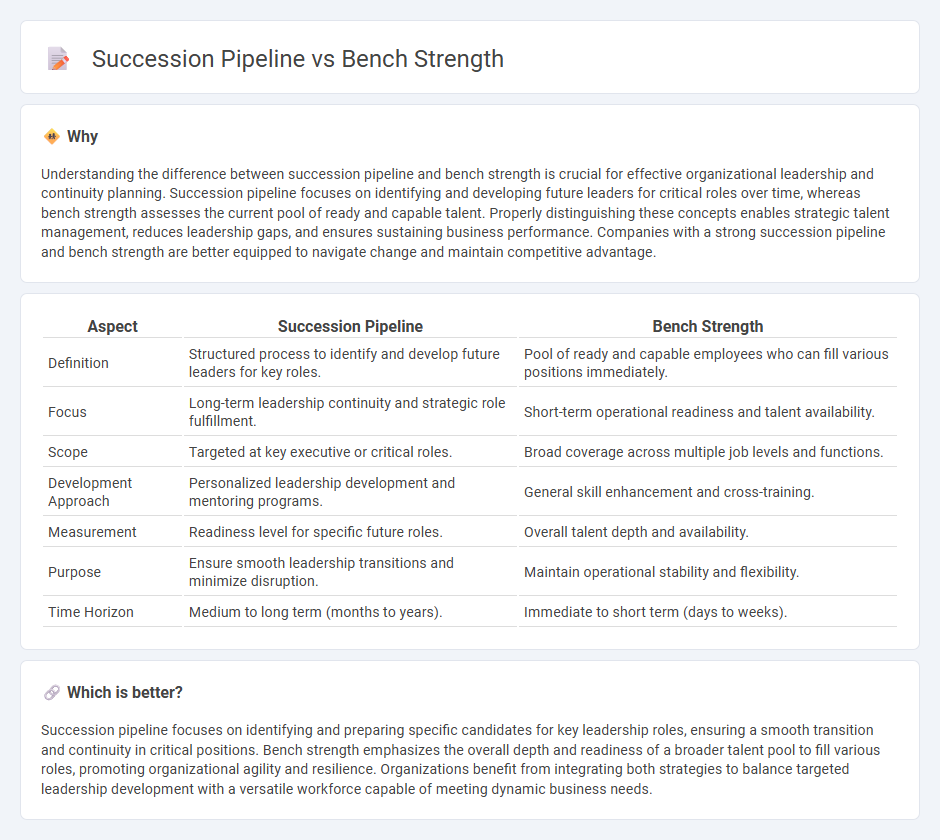
Succession pipeline focuses on identifying and developing specific individuals for key leadership roles, ensuring a seamless transition when vacancies arise. Bench strength emphasizes maintaining a pool of talented employees capable of stepping into various positions, enhancing organizational flexibility and resilience. Explore how balancing succession pipeline and bench strength strategies can drive effective management continuity.
Why it is important
Understanding the difference between succession pipeline and bench strength is crucial for effective organizational leadership and continuity planning. Succession pipeline focuses on identifying and developing future leaders for critical roles over time, whereas bench strength assesses the current pool of ready and capable talent. Properly distinguishing these concepts enables strategic talent management, reduces leadership gaps, and ensures sustaining business performance. Companies with a strong succession pipeline and bench strength are better equipped to navigate change and maintain competitive advantage.
Comparison Table
| Aspect | Succession Pipeline | Bench Strength |
|---|---|---|
| Definition | Structured process to identify and develop future leaders for key roles. | Pool of ready and capable employees who can fill various positions immediately. |
| Focus | Long-term leadership continuity and strategic role fulfillment. | Short-term operational readiness and talent availability. |
| Scope | Targeted at key executive or critical roles. | Broad coverage across multiple job levels and functions. |
| Development Approach | Personalized leadership development and mentoring programs. | General skill enhancement and cross-training. |
| Measurement | Readiness level for specific future roles. | Overall talent depth and availability. |
| Purpose | Ensure smooth leadership transitions and minimize disruption. | Maintain operational stability and flexibility. |
| Time Horizon | Medium to long term (months to years). | Immediate to short term (days to weeks). |
Which is better?
Succession pipeline focuses on identifying and preparing specific candidates for key leadership roles, ensuring a smooth transition and continuity in critical positions. Bench strength emphasizes the overall depth and readiness of a broader talent pool to fill various roles, promoting organizational agility and resilience. Organizations benefit from integrating both strategies to balance targeted leadership development with a versatile workforce capable of meeting dynamic business needs.
Connection
Succession pipeline and bench strength are interconnected concepts essential for effective management, ensuring leadership continuity and organizational resilience. A robust succession pipeline identifies and develops key talent, while strong bench strength provides a pool of qualified candidates ready to fill critical roles. Together, they minimize disruption during leadership transitions and support long-term business growth.
Key Terms
Talent Pool
Bench strength refers to the immediate availability of skilled employees ready to fill key roles, ensuring operational continuity without disruption. Succession pipeline focuses on the strategic development of high-potential talent for future leadership and critical positions, emphasizing long-term organizational growth. Explore more insights on building a robust talent pool to enhance workforce resilience and leadership readiness.
Leadership Development
Bench strength measures the depth of ready talent within an organization to fill key roles quickly, while a succession pipeline strategically develops future leaders through targeted training and experience. Leadership development programs are crucial for enhancing bench strength by equipping high-potential employees with the skills needed to assume leadership positions. Explore how integrating leadership development can optimize both bench strength and succession pipelines for sustained organizational success.
Critical Roles
Bench strength refers to the depth of ready-now talent available to fill critical roles quickly, ensuring leadership continuity and operational stability. Succession pipeline emphasizes a strategic, long-term development of high-potential employees to assume critical roles over time, promoting sustainable organizational growth. Explore effective strategies to balance bench strength and succession pipeline for critical role readiness and organizational resilience.
Source and External Links
Building Bench Strength for Your Organization - NKU Article - Bench strength in an organization refers to the pool of competent employees qualified to fill critical leadership roles immediately, similar to how sports teams have substitute players ready to step in.
Bench press - The term "bench strength" is different from the bench press exercise, which is a weight training movement targeting muscles like the pectoralis major, deltoids, and triceps.
Bench Press Strength Standards for Men and Women (lb) - Average bench press strength standards help individuals gauge their lifting capacity, but this is unrelated to the organizational concept of bench strength which deals with talent readiness.
 dowidth.com
dowidth.com